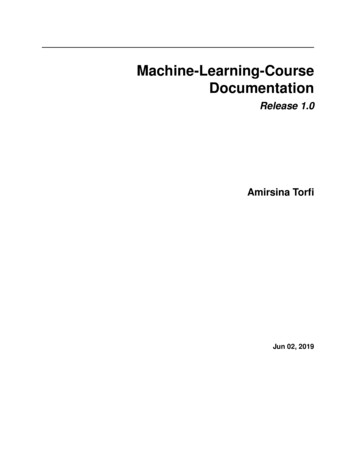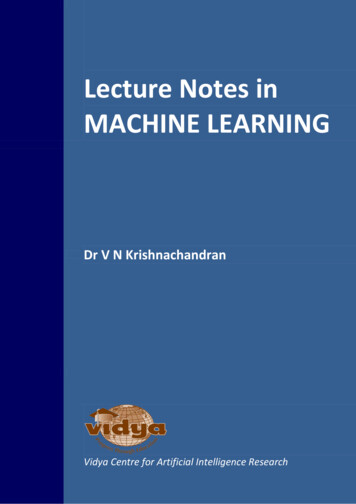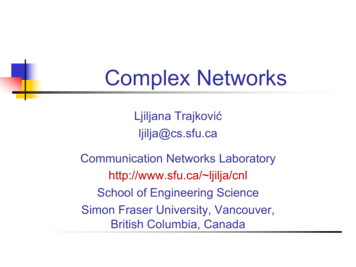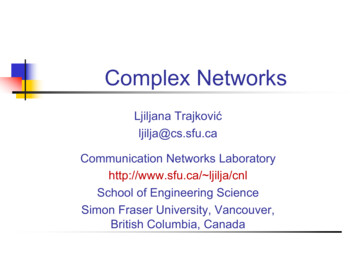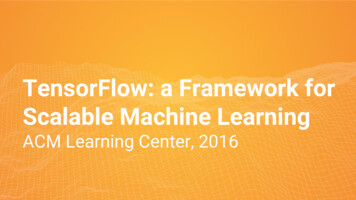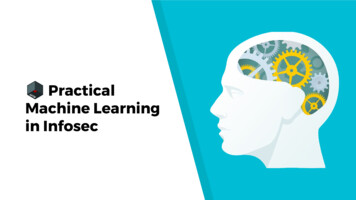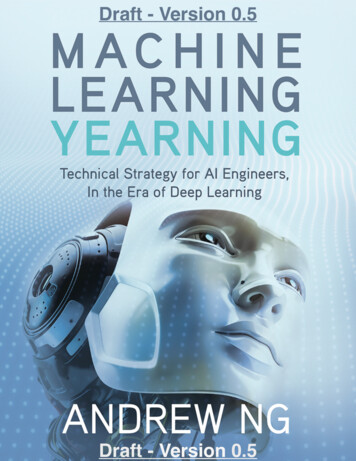
Transcription
Quick Review Artificial Intelligence and Machine Learning Machine Learning Capabilities Taxonomy of Machine Learning ProblemsIntroduction to Machine LearningMark A. AustinUniversity of Marylandaustin@umd.eduENCE 688P, Spring Semester 2022March 1, 2022
Quick Review Artificial Intelligence and Machine Learning Machine Learning Capabilities Taxonomy of Machine Learning ProblemsOverview1Quick Review2Artificial Intelligence and Machine Learning3Machine Learning Capabilities4Taxonomy of Machine Learning Problems5Types of Machine Learning Systems6Urban Applications7Recent Research at PEER and UMD
Quick Review Artificial Intelligence and Machine Learning Machine Learning Capabilities Taxonomy of Machine Learning ProblemsQuick Review
Quick Review Artificial Intelligence and Machine Learning Machine Learning Capabilities Taxonomy of Machine Learning ProblemsMan and Machine (Traditional View)ManMachineGood at formulatingsolutions to problems.Manipulates Os and 1s.Can work with incompletedata and information.Requires precisedecriptions of problemsolving procedures.Creative.Reasons logically, but veryslow.Performance is static.Humans break the rules.Very specific abilities.Dumb, but very fast.Performance doublesevery 18-24 months.Machines will follow therules.
Quick Review Artificial Intelligence and Machine Learning Machine Learning Capabilities Taxonomy of Machine Learning ProblemsImportance of Sensor NetworksPathway from sensing and data collection to . action . improvedperformance.Chain of dependency relationships:1.2.3.4.5.improved performanceactionsidentify eventsdata processingtypes and quality of -- actions -- ability to identify events. -- data processing -- types and quality of datadata -- sensor design and placement.
Quick Review Artificial Intelligence and Machine Learning Machine Learning Capabilities Taxonomy of Machine Learning ProblemsPathway to System EfficiencyWe need computational models that:Improve situational awareness – to understand what is actuallyhappening in a building or city?Connect sensor measurements to short- and long-term urbanneeds (e.g., decisions on a bus stop; longer term urbanplanning).Capture the spatial, temporal, and intensity aspects ofenvironmental phenomena (e.g., fires, flooding) and theirimpact on natural (e.g., air quality) and man-made systems(e.g., transportation networks, food chains).Look ahead and forecast future states of the system?
Quick Review Artificial Intelligence and Machine Learning Machine Learning Capabilities Taxonomy of Machine Learning ProblemsArtificial IntelligenceandMachine LearningOpportunity: Can use AI/ML tosolve problems in completely new ways.
Quick Review Artificial Intelligence and Machine Learning Machine Learning Capabilities Taxonomy of Machine Learning ProblemsArtificial Intelligence (AI) and Machine Learning (ML)Technical Implementation (2020, Google, Siemens, IBM)AI and ML will be deeply embedded in new software andalgorithms.Artificial Intelligence:Knowledge representation and reasoning with ontologies andrules. Semantic graphs. Executable event-based processing.Machine Learning:Modern neural networks. Input-to-output prediction.Data mining.Identify objects, events, and anomalies.Learn structure and sequence. Remember stuff.
Quick Review Artificial Intelligence and Machine Learning Machine Learning Capabilities Taxonomy of Machine Learning ProblemsMan and Machine (AI-ML View)ManGood at formulatingsolutions to problems.Can work with incompletedata and information.AI-ML MachineManipulates Os and 1s.Can work with incompletedata and information.Creative.Creative.Fast logical reasoning.Reasons logically, but veryslow. Forgetful.Performance doublesevery 18-24 months.Performance is static.Data mining can discoverthe rules.Humans make the rules,then they break them.
Quick Review Artificial Intelligence and Machine Learning Machine Learning Capabilities Taxonomy of Machine Learning ProblemsTraditional Programming vs AI-ML Workflow
Quick Review Artificial Intelligence and Machine Learning Machine Learning Capabilities Taxonomy of Machine Learning ProblemsTraditional Programming vs AI-ML Workflow
Quick Review Artificial Intelligence and Machine Learning Machine Learning Capabilities Taxonomy of Machine Learning ProblemsSensor Networks and AI-ML Enabled Decision MakingDependencies Among Systems in Built Environment:Courtesy: DHSPathway to Enhanced Situational Awareness/Decision Making:Gather and process sensed data.Mine data to understand relationships.Integrate predictions into decision making framework.
Quick Review Artificial Intelligence and Machine Learning Machine Learning Capabilities Taxonomy of Machine Learning ProblemsSensor Networks and AI-ML Enabled Decision MakingPathway from sensing and data collection to . action . improvedperformance, now enabled by AI and ML capabilities:
Quick Review Artificial Intelligence and Machine Learning Machine Learning Capabilities Taxonomy of Machine Learning ProblemsSoftware Support in Python and JavaSoftware Support in Python:Pandas (for tabular data analysis).TensorFlow (open source library for machine learning).Keras (neural network library).Jupyter Notebook (for web-based authoring of documents).Anaconda (packages to perform data science in Python/R).Software Support in Java:Apache Jena (for knowledge representation and reasoning).Weka (for data mining).Deep Learning for Java (DL4J) (for machine learning).Note: Jupyter Julia, Python and R.
Quick Review Artificial Intelligence and Machine Learning Machine Learning Capabilities Taxonomy of Machine Learning ProblemsMachine LearningCapabilities
Quick Review Artificial Intelligence and Machine Learning Machine Learning Capabilities Taxonomy of Machine Learning ProblemsA Brief History1943: First neural networks invented (McCulloch and Pitts)1958-1969: Perceptrons (Rosenblatt, Minsky and Papert).1980s-1990s: CNN, Back Propagation.1990s-2010s: SVMs, decision trees and random forests.2010s: Deep Neural Networks and deep learning.
Quick Review Artificial Intelligence and Machine Learning Machine Learning Capabilities Taxonomy of Machine Learning ProblemsMachine Learning Capabilities (1980-1990)
Quick Review Artificial Intelligence and Machine Learning Machine Learning Capabilities Taxonomy of Machine Learning ProblemsMachine Learning Capabilities (1997-2014)
Quick Review Artificial Intelligence and Machine Learning Machine Learning Capabilities Taxonomy of Machine Learning ProblemsMachine Learning Capabilities (1997-2014)
Quick Review Artificial Intelligence and Machine Learning Machine Learning Capabilities Taxonomy of Machine Learning ProblemsMachine Learning Capabilities (2014-present)
Quick Review Artificial Intelligence and Machine Learning Machine Learning Capabilities Taxonomy of Machine Learning ProblemsMachine Learning Capabilities (2014-present)
Quick Review Artificial Intelligence and Machine Learning Machine Learning Capabilities Taxonomy of Machine Learning ProblemsMachine Learning Capabilities (2014-present)
Quick Review Artificial Intelligence and Machine Learning Machine Learning Capabilities Taxonomy of Machine Learning ProblemsTaxonomy of Machine Learning ProblemsTaxonomy ofMachine Learning Problems
Quick Review Artificial Intelligence and Machine Learning Machine Learning Capabilities Taxonomy of Machine Learning ProblemsClassification of Machine Learning ProblemsTree of Machine Learning and Deep Learning Capabilities
Quick Review Artificial Intelligence and Machine Learning Machine Learning Capabilities Taxonomy of Machine Learning ProblemsClassification of Machine Learning ProblemsRegression versus Classification
Quick Review Artificial Intelligence and Machine Learning Machine Learning Capabilities Taxonomy of Machine Learning ProblemsClassification of Machine Learning ProblemsBinary and Multi-Class ClassificationTask of separating elements of a set into two (or more) groups onthe basis of a classification rule (e.g., shape, color, etc).
Quick Review Artificial Intelligence and Machine Learning Machine Learning Capabilities Taxonomy of Machine Learning ProblemsClassification of Machine Learning ProblemsCurse of DimensionalityMachine learning problems are inherently statistical and involvehigh-dimensional data. Increases in the problem dimensionality,decrease the number of data points available for classification ineach dimension.
Quick Review Artificial Intelligence and Machine Learning Machine Learning Capabilities Taxonomy of Machine Learning ProblemsClassification of Machine Learning ProblemsDimensionality ReductionStrategies of dimensionality reduction involve transformation ofdata to new (lower) dimension in such a way that some of thedimensions can be discarded without a loss of information.Example: Projection of Swiss Roll data in 3D to 2D .
Quick Review Artificial Intelligence and Machine Learning Machine Learning Capabilities Taxonomy of Machine Learning ProblemsClassification of Machine Learning ProblemsAutoencodersAutoencoder neural networks use unsupervised machine learningalgorithms to: (1) find compressed representations of the inputdata (encoder), and (2) reconstruct the original data from thecompressed data (decoder).Applications:Dimensionality reduction.Image processing (compression and denoising).Feature extraction; anomaly detection.Image generation.Sequence-to-sequence translation.Recommendation systems.
Quick Review Artificial Intelligence and Machine Learning Machine Learning Capabilities Taxonomy of Machine Learning ProblemsClassification of Machine Learning ProblemsAutoEncoder tdataReconstructedOutputxˆ1x1Latent Spacex2xˆ2x3xˆ3x4xˆ4xixˆiEncoded dataxnHidden nodesInput nodesxˆn
Quick Review Artificial Intelligence and Machine Learning Machine Learning Capabilities Taxonomy of Machine Learning ProblemsClassification of Machine Learning ProblemsEncoderThe encoder learns how to reduce the input dimensions andcompress the input data into an encoded representation.DecoderThe decoder learns how to reconstruct the input data from theencoded representation and be as close to the input data aspossible.Latent SpaceLatent space is simply a representation of compressed data inwhich similar points are closer together in space. This formalism isuseful for learning data features and finding similar representationsof data for analysis.
Quick Review Artificial Intelligence and Machine Learning Machine Learning Capabilities Taxonomy of Machine Learning ProblemsClassification of Machine Learning ProblemsImageNet and Deep Learning (2009-present)Indexed Database of 14.2 million ImagesProject initiated by Fei Fei Li in 2006Image annotation process crowd sourced via Amazon’sMechanical Turk. Categories derived from WordNet.Well organized supervised machine learning.
Quick Review Artificial Intelligence and Machine Learning Machine Learning Capabilities Taxonomy of Machine Learning ProblemsClassification of Machine Learning ProblemsImageNet and Deep Learning Capabilities:Identify objects in an image.27 high-level categories; 21,800 sub-categories.
Quick Review Artificial Intelligence and Machine Learning Machine Learning Capabilities Taxonomy of Machine Learning ProblemsImageNet and Deep LearningCapabilities (2018):Identify relationship among multiple objects in a image.Example. Dog riding skateboard
Quick Review Artificial Intelligence and Machine Learning Machine Learning Capabilities Taxonomy of Machine Learning ProblemsImageNet and Deep LearningCaptions generated by a neural network:
Quick Review Artificial Intelligence and Machine Learning Machine Learning Capabilities Taxonomy of Machine Learning ProblemsMachine Learning at ScaleObject-recognition module:24 million nodes.140 million parameters.15 billion connections.Source: Fei Fei Li, TEDTalk, YouTube 2015.
Quick Review Artificial Intelligence and Machine Learning Machine Learning Capabilities Taxonomy of Machine Learning ProblemsClassification of Machine Learning ProblemsVariational AutoEncoders (Generative Models)InputdataEncoderDecoderLatent Statex1DistributionsGeneratedOutputy1Sample nput nodes
Quick Review Artificial Intelligence and Machine Learning Machine Learning Capabilities Taxonomy of Machine Learning ProblemsClassification of Machine Learning ProblemsStandard Autoencoders vs. Variational Autoencoders:A standard autoencoder outputs a single value for eachencoding dimension.Variational autoencoders provide a probability distribution foreach latent attribute.Example: Single value representations for latent attributes:
Quick Review Artificial Intelligence and Machine Learning Machine Learning Capabilities Taxonomy of Machine Learning ProblemsClassification of Machine Learning ProblemsDiscrete Value and Probability Distribution: Representationsfor smile latent attribute:
Quick Review Artificial Intelligence and Machine Learning Machine Learning Capabilities Taxonomy of Machine Learning ProblemsClassification of Machine Learning ProblemsImage Reconstruction: sampled from latent distributions .Source: Jordan J., Variational Autoencoders, Data Science, March2018.
Quick Review Artificial Intelligence and Machine Learning Machine Learning Capabilities Taxonomy of Machine Learning ProblemsTypes of Machine LearningTypes ofMachine Learning Systems
Quick Review Artificial Intelligence and Machine Learning Machine Learning Capabilities Taxonomy of Machine Learning ProblemsMachine Learning SystemsTypes of Machine Learning Systems:Supervised machine learning.Unsupervised machine learning.Semi-supervised machine learning.Reinforcement machine learning.
Quick Review Artificial Intelligence and Machine Learning Machine Learning Capabilities Taxonomy of Machine Learning ProblemsSupervised Machine LearningSupervised Machine LearningLearning algorithms are trained with labeled data and adjust themodel parameters to minimize the discrepancy between thecomputed output and desired output.Data(x,y):x is data, y is the label.Goal:Learn function to map x y.Common Algorithms: Regression, classification, naive bayes,object detection, neural networks, random forests, convolutionneural networks.
Quick Review Artificial Intelligence and Machine Learning Machine Learning Capabilities Taxonomy of Machine Learning ProblemsSupervised Machine LearningSupervised Machine Learning Process and TestingChallenges:Data preparation and pre-processing; avoid unlikely andincomplete data.Identifying the right features to train the machine on.
Quick Review Artificial Intelligence and Machine Learning Machine Learning Capabilities Taxonomy of Machine Learning ProblemsSupervised Machine LearningAdvantagesCan predict output based on previous experiences.Can have an exact idea about the classes of objects.Very useful in real-world applications such as fraud detection.DisadvantagesNot suitable for solution of complex tasks.Domain of expertise is very narrow – cannot predict correctoutput if test data is different from training dataset.Training requires prior knowledge of the classes of objects.Manual labeling of a large data set can be very timeconsuming.
Quick Review Artificial Intelligence and Machine Learning Machine Learning Capabilities Taxonomy of Machine Learning ProblemsUnsupervised Machine LearningUnsupervised Machine LearningLearning algorithms examine the structure of unlabeled data, anddivide it into groups having the closest features.Data(x):x is data, no labels.Goal:Learn hidden or underlying structure (or patterns in) of thedata.Common Algorithms: K-means clustering, feature ordimensionality reduction.
Quick Review Artificial Intelligence and Machine Learning Machine Learning Capabilities Taxonomy of Machine Learning ProblemsUnsupervised Machine LearningUnsupervised Machine Learning ProcessAbilities and ChallengesNo supervision needed.Unsupervised learning is closer to human cognitive function –it deduces patterns from a wide variety of application andlearns over time.
Quick Review Artificial Intelligence and Machine Learning Machine Learning Capabilities Taxonomy of Machine Learning ProblemsUnsupervised Machine LearningAdvantagesAbility for a machine to tackle problems that humans mightfind insurmountable.Ideal for exploring raw and unknown data – training data doesnot need to be labelled.DisadvantagesLower accuracy of results because the input data is nowknown and not labeled by people in advance.User needs to spend time interpreting and labelingclasses/groups which follow classification.
Quick Review Artificial Intelligence and Machine Learning Machine Learning Capabilities Taxonomy of Machine Learning ProblemsSummary: Supervised Learning vs Unsupervised Learning
Quick Review Artificial Intelligence and Machine Learning Machine Learning Capabilities Taxonomy of Machine Learning ProblemsSemi-Supervised LearningSemi-Supervised LearningSemi-supervised learning is an approach to machine learning wherealgorithms use large amounts of unlabeled data to augment smallamounts of labeled data to improve predictive accuracy.Semi-Supervised Learning in HumansConcept learning in Children:Let x animal, y concept (e.g., cat).Parent points to animal and says: cat!Children subsequently observe animals by themselves andincrementally refine understanding.
Quick Review Artificial Intelligence and Machine Learning Machine Learning Capabilities Taxonomy of Machine Learning ProblemsSemi-Supervised LearningUnlabeled and Labeled Data
Quick Review Artificial Intelligence and Machine Learning Machine Learning Capabilities Taxonomy of Machine Learning ProblemsSemi-Supervised LearningAlgorithmsSelf-training, generative models, co-training.Graph-based algorithms.Semi-supervised support vector machines.ApplicationsSpeech recognition and analysis.Spam detection and filtering.Video surveilance.2D and 2D structure prediction.
Quick Review Artificial Intelligence and Machine Learning Machine Learning Capabilities Taxonomy of Machine Learning ProblemsSemi-Supervised LearningAdvantagesProvides the benefits of both unsupervised and supervisedlearning while avoiding the challenge of finding large amountsof labeled data.DisadvantagesCannot provide significant benefits over supervised learningunless one is absolutely sure that an assumption holds on therelationship between labels and the unlabeled datadistribution.Mathematically, we need:p(x, y ) p(y )p(x y ),where p(x y ) is an identifiable mixture model.(1)
Quick Review Artificial Intelligence and Machine Learning Machine Learning Capabilities Taxonomy of Machine Learning ProblemsReinforcement LearningReinforcement LearningReinforcement learning algorithms use trial-and-error procedures todetermine which action can provide the greatest reward.Data: state-action pairs.Goal: Maximize future rewards over many time steps.Examples: Taking actions to enhance survival/performance ingaming, robotics, optimization of operations for industrialmachinery.
Quick Review Artificial Intelligence and Machine Learning Machine Learning Capabilities Taxonomy of Machine Learning ProblemsReinforcement LearningUsing Reinforcement to Improve Memory Retention
Quick Review Artificial Intelligence and Machine Learning Machine Learning Capabilities Taxonomy of Machine Learning ProblemsReinforcement LearningReinforcement Learning ProcessIn technical terms, reinforcement learning is a process in which asoftware agent makes observations and takes actions within anenvironment, and in return, it receives rewards.The main objective is to maximize long-term rewards.
Quick Review Artificial Intelligence and Machine Learning Machine Learning Capabilities Taxonomy of Machine Learning ProblemsReinforcement LearningDefinitions:Environment: Physical world in which the agent is operating.State: Current situation of the agent.Reward: Feedback from the environment.Policy: Method of map agent’s state to actions.Value: Future reward that an agent would receive by takingan action in a particular state.Note:These conditions may not always be present in real-worldapplications.More Details: See Technical Tutorial on RL by Pieter Abbeel andJohn Schulman at UC Berkeley.
Quick Review Artificial Intelligence and Machine Learning Machine Learning Capabilities Taxonomy of Machine Learning ProblemsReinforcement LearningSimple Example: Mouse Searches Maze to find Cheese
Quick Review Artificial Intelligence and Machine Learning Machine Learning Capabilities Taxonomy of Machine Learning ProblemsReinforcement LearningClassic and Deep Reinforcement Learning
Quick Review Artificial Intelligence and Machine Learning Machine Learning Capabilities Taxonomy of Machine Learning ProblemsReinforcement LearningAdvantagesReinforcement learning can be used to solve very complexproblems that cannot be solved by conventional techniques.Errors can be corrected during the learning process.Learning process is very similar to humans, but it can oftenoutperform humans .DisadvantagesNot suitable for solving simple problems.Reinforcement learning requires lots of data and computation.Assumes incorrectly that the World follows a Markovianmodel, described in terms of sequences of possible events inwhich the probability of each event depends only on thecurrent state.
Quick Review Artificial Intelligence and Machine Learning Machine Learning Capabilities Taxonomy of Machine Learning ProblemsUrban Applications
Quick Review Artificial Intelligence and Machine Learning Machine Learning Capabilities Taxonomy of Machine Learning ProblemsOpportunities for Machine LearningMachine Learning Opportunities:Predicting system response and performance.Interpreting data and formulating models to predictcomponent and subsystem-level properties.Information retrieval from images and text.Recognizing patterns in streams of sensed data.Economic Considerations:Urban infrastructure is permanent/semi-permanent and veryexpensive to build and maintain.Prioritize improvements to efficiency by identifying andremoving bottlenecks in performance.Use AI-ML for design of actions that enhancebehavior/system performance.
Quick Review Artificial Intelligence and Machine Learning Machine Learning Capabilities Taxonomy of Machine Learning ProblemsSmall Scale: Traffic Intersection at UMDGoal. How to traverse a traffic intersection safely and withoutcausing an accident?Required Capability. Observe, evaluate, reason, take actions.Challenges. Multiple types of data, event-driven behavior,dynamic, time critical. Too much traffic congestion.
Quick Review Artificial Intelligence and Machine Learning Machine Learning Capabilities Taxonomy of Machine Learning ProblemsSelf-Driving CarsGoal. Improve performance by removing bottlenecks no humandriver; no traffic lights.
Quick Review Artificial Intelligence and Machine Learning Machine Learning Capabilities Taxonomy of Machine Learning ProblemsGoogle Self-Driving CarEssentially: A network of sensors and computers on wheels.Today: Modern automobiles 100 million lines of code.Tomorrow: Self-driving automobiles 300 million lines of code.
Quick Review Artificial Intelligence and Machine Learning Machine Learning Capabilities Taxonomy of Machine Learning ProblemsNavigating a Busy Traffic IntersectionStep-by-Step Procedure:Identify various kinds of objects (e.g., vehicles, crosswalk).Predict what objects will do next.Conduct safety assessment.Take action.
Quick Review Artificial Intelligence and Machine Learning Machine Learning Capabilities Taxonomy of Machine Learning ProblemsGoogle DeepMind (2018-2020)Teach Self-Driving Cars to Navigate a City without a MapTest Cities: London, Paris, New York.
Quick Review Artificial Intelligence and Machine Learning Machine Learning Capabilities Taxonomy of Machine Learning ProblemsResearch at PEER
Quick Review Artificial Intelligence and Machine Learning Machine Learning Capabilities Taxonomy of Machine Learning ProblemsML Research at PEERPEER Hub ImageNet (2018): Classification of StructuralEngineering allenge/detection-tasks/
Quick Review Artificial Intelligence and Machine Learning Machine Learning Capabilities Taxonomy of Machine Learning ProblemsML Research at PEERFuture Work: Create pathway from image classification todecision making:
Quick Review Artificial Intelligence and Machine Learning Machine Learning Capabilities Taxonomy of Machine Learning ProblemsPreliminary Research atUMD
Quick Review Artificial Intelligence and Machine Learning Machine Learning Capabilities Taxonomy of Machine Learning ProblemsLarge Scale: Management of City OperationsRequired Capability. Modeling and Control of Urban Processes.Challenges. Distributed system behavior/control. Decisionmaking covers a wide range of temporal and spatial scales.
Quick Review Artificial Intelligence and Machine Learning Machine Learning Capabilities Taxonomy of Machine Learning ProblemsLarge Scale: Management of City OperationsCase Study A (2019): Mine publically available data tounderstand Energy Consumption in 2,500 Buildings in Chicago.
Quick Review Artificial Intelligence and Machine Learning Machine Learning Capabilities Taxonomy of Machine Learning ProblemsLarge Scale: Management of City OperationsCase Study B (2020): Can we teach a machine to understandthe structure and behavior of water supply networks?Reference: Coelho M., et al., Teaching Machines to UnderstandUrban Networks, ICONS 2020.
Quick Review Artificial Intelligence and Machine Learning Machine Learning Capabilities Taxonomy of Machine Learning ProblemsReferencesAustin M.A., Delgoshaei P., Coelho M. and Heidarinejad M. ,Architecting Smart City Digital Twins: Combined Semantic Modeland Machine Learning Approach, Journal of Management inEngineering, ASCE, Volume 36, Issue 4, July, 2020.Coelho M., and Austin M.A. , Teaching Machines to UnderstandUrban Networks, The Fifteenth International Conference on Systems(ICONS 2020), Lisbon, Portugal, February 23-27, 2020, pp. 37-42.Bhiksha R., Introduction to Neural Networks, Lisbon MachineLearning School, June, 2018.Lu T., Fundamental Limitations of Semi-Supervised Learning, MSThesis in Mathematics in Computer Science, University of Waterloo,Canada, 2009.Van Engelen J.E., and Hoos H.H., A Survey on Semi-SupervisedLearning, Machine Learning, Vol. 109, 2020, pp. 373-440.
Quick Review Arti cial Intelligence and Machine Learning Machine Learning Capabilities Taxonomy of Machine Learning Problems Types of Machine Learning Systems Urban Applications Recent Research at PEER and UMD Introduction to Machine Learning Mark A. Austin University of Maryland austin@umd.edu ENCE 688P, Spring Semester 2022 March 1, 2022


